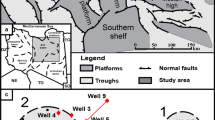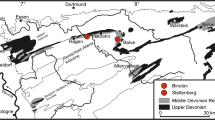Abstract
In order to evaluate the geological record of climatic change in neritic carbonates, we studied Late Miocene rock outcrops in southern Spain. Six episodes of reef growth are documented (Burdigalian to Messinian) in Neogene basins of the Betic Cordillera, which were located close to the margin of the global reef belt. The reefs are characterized by various zooxanthellate corals which decrease in diversity with time, andHalimeda; the youngest reefs of the latest Messinian are characterized by the dominance of the genusPorites. Late Miocene coral reefs and reef-rimmed platforms alternate over time with non-reefal carbonate ramps characterized by skeletal calcirudites or with gypsum such as that formed during the Messinian salinity crisis. The calcirudites lack reef corals, calcified green algae and extensive marine cement, but exhibit skeletal components described from both modern and fossil nontropical carbonates. These include bryozoans, mollusks, foraminifers, echinoderms and minor balanids, as well as coralline algae of a bryomol association. The presence of some larger foraminifers indicates high temperatures, close to the lower temperature threshold of the reef assemblage. Sea level lowstands and highstands are documented by wedges of bryomol carbonate and chlorozoan patch reefs or prograding platforms. Thus, temperate climate depositional modes correspond to relatively low sea levels, and warm-water modes to high sea levels. The Neogene infill of the Agua Amarga and Sorbas basins documents two of these cycles. Other climate/sea-level cycles (including Messinian gypsum in the cool water depositional mode) are well established in adjacent Neogene basins in southern Spain. This type of composite sequence seems to occur only along the margin of the global reef belt and indicates an oscillatory latitudinal movement of the margin, which is associated with global climatic change. The analysis of turnover in neritic depositional carbonate systems may therefore be considered a sensitive tool for reconstructing climatic change from the fossil record. However, warm-water modes and temperate-water modes of carbonate sedimentation and diagenesis differ significantly. For this reason the interpretation of composite system sequences by sequence stratigraphy requires an extended concept. The particular type of mixed bryomolchlorozoan depositional sequence also bears some potential for drowning, because sea level rise may be faster than the net production rate of temperate carbonate systems.
Similar content being viewed by others
References
Alexandersson ET (1972) Marine maceration of skeletal carbonates in the Skagerrak, North Sea. Sedimentology 26:844–852
Battistini G di, Toscani L, Iaccarino S, Villa IM (1987) K/Ar ages and the geological setting of calc-alkaline volcanic rocks from Sierra de Gata, SE Spain. N Jahrb Mineral 1987:369–383
Betzler C, Brachert TC, Kroon D (1995) Role of climate in partial drowning of the Queensland Plateau carbonate platform (northeastern Australia). Mar Geol 123:11–32
Brachert TC, Dullo W-CHR (1991) Laminar micrite crusts and associated foreslope processes. J Sediment Petrol 61:354–363
Brachert TC, Betzler C, Feary DA, Davies PJ (1993) Climatic change: control on carbonate platform development (Eocene-Miocene, Leg 133, northeastern Australia). Proc Ocean Drilling Program Sci Res 133:291–300
Braga JC, Martin JM (1988) Neogene coralline-algal growth forms and their palaeoenvironments in the Almanzora River valley (Almeria, S.E. Spain). Palaeogeogr Palaeoclim Palaeoecol 67:285–303
Braga JC, Martin JM (1992) Late Miocene carbonate sequences of southeastern Spain: a guidebook for the Las Negras and Sorbas Areas, Part II: Sorbas area. Field trip guide book SEPM/IAS research conference, 30 August to 3 September, La Seu, Spain, pp 78–108
Braga JC, Martin JM, Alcala B (1990) Coral reefs in coarse-terrigenous sedimentary environments (Upper Tortonian, Granada basin, southern Spain). Sediment Geol 66:135–150
Braga JC, Martin JM, Betzler C, Brachert TC, Civis J, Sierro FJ (1994) Carbonatos templados Tortonienses de la cuenca de Agua Amarga (Almeria, SE España). II. Congreso del Grupo Espanol del Tertiario, Jaca
Brongersma-Sanders M (1971) Origin of major cyclicity of evaporites and bituminous rocks: an actualistic model. Mar Geol 11:123–144
Cande SC, Kent DV (1922) A new geomagnetic polarity time-scale for the late Cretaceous and Cenozoic. J Geophys Res 97:13917–13951
Carannante G, Simone L (1988) Foramol carbonate shelves as depositional site and source area: recent and ancient examples from the Mediterranean. Am Assoc Petrol Geol Bull 72:993–994
Carannante G, Esteban M, Milliman JD, Simone L (1988) Carbonate lithofacies as palaeolatitude indicators: problems and limitations. Sediment Geol 60:333–346
CLIMAP Project Members (1976) The surface of the Ice-Age earth. Science 191:1131–1137
Collins LB, Zhu ZR, Wyrwoll K-H, Hatcher BG, Playford PE, Eisenhauer A, Chen JH, Wasserburg GJ, Bonani G (1993): Holocene growth history of a reef complex on a cool-water carbonate margin: Easter Group of the Houtman Abrolhos, eastern Indian Ocean. Mar Geol 115:29–46
Copper P (1988) Ecological successions in Phanerozoic reef ecosystems: Is it real? Palaios 3:136–152
Crowley TJ (1994) Pleistocene temperature changes. Nature 371:664
Dabrio CJ, Esteban M, Martin JM (1981) The coral reef of Nijar, Messinian (uppermost Miocene), Almeria Province, S.E. Spain. J Sediment Petrology 51:521–539
Dravis J (1979) Rapid and widespread generation of recent oolithic hardgrounds on a high energy platform, Eleuthera Bank, Bahamas. J Sediment Geol 49:195–208
Esteban M (1979) Significance of the upper Miocene coral reefs of the western Mediterranean. Palaeogeogr Palaeoclim Palaeoecol 29:169–188
Esteban M, Braga JC, Martin JM (1995) Western Mediterranean. In: NN (eds) Miocene reefs, a global comparison. Springer, Berlin Heidelberg New York (in press)
Flügel E (1982) Microfacies analysis of limestones. Springer, Berlin Heidelberg New York, pp 1–633
Flügel E (1988)Halimeda: palaeontological record and palaeoenvironmental significance. Coral Reefs 6:123–131
Fulthorpe CS, Schlanger SO (1989) Palaeo-Oceanographic and tectonic setting of Early Miocene reefs and associated carbonates offshore southeast Asia. Am Assoc Petrol Geol Bull 73:729–756
Grammer GM, Ginsburg RN, Swart PK, McNeill DF, Jull AJT, Prezbindowski DR (1993) Rapid growth rates of syndepositional marine aragonite cements in steep marginal slope deposits, Bahamas and Belize. J Sediment Petrol 63:983–989
Guilderson TP, Fairbanks RG, Rubenstone JL (1994) Tropical temperature variations since 20 000 years ago: modulating interhemispheric climate change. Science 263:663–665
Haq BU, Hardenbohl J, Vail PJ (1988) Mesozoic and Cenozoic chronostratigraphy and eustatic cycles. Soc Econ Palaeontol Mineral Spec Publ 42:71–108
James NP, Bone Y (1989) Petrogenesis of Cenozoic temperate water calcarenites, south Australia: a model for meteoric/shallow burial diagenesis of shallow water calcite sediments. J Sediment Petrol 59:191–204
James NP, Bone Y (1991) Origin of a cool-water, Oligo-Miocene deep shelf limestone, Eucla Platform, southern Australia. Sedimentology 38:323–341
James NP, Borch CC von der (1991) Carbonate shelf edge off southern Australia: a prograding open-platform margin. Geology 19:1005–1008
James NP, Boreen TD, Bone Y, Feary DA (1994) Holocene carbonate sedimentation on the west Eucla Shelf, Great Australian Bight: a shaved shelf. Sediment Geol 90:161–177
Kendall GSC, Lerche I (1988) The rise and fall of eustasy. Soc Econ Paleontol Mineral Spec Publ 42:3–18
Lees A (1975) Possible influence of salinity and temperature on modern shelf carbonate sedimentation. Mar Geol 19:159–198
Lees A, Buller AT (1972) Modern temperate-water and warm water shelf carbonate sediments contrasted. Mar Geol 13:M67-M73
Longman MA (1980) Carbonate diagenetic textures from nearsurface diagenetic environments. Am Assoc Petrol Geol Bull 64:461–487
Loucks RG, Sarg JF (1993) Carbonate sequence stratigraphy: recent developments and applications. Am Assoc Petrol Geol Mem 57:pp 1–545
Macintyre IG (1985) Submarine cements — the peloidal question. Soc Econ Palaeontol Mineral Spec Publ 36:109–116
Martin JM, Braga JC (1994) Messinian events in the Sorbas basin in southeastern Spain and their implications in the recent history of the Mediterranean. Sediment Geol 90:257–268
Martin JM, Braga JC (1995) Tectonic signals in the Messinian stratigraphy of the Sorbas basin (Almeria, SE Spain). In: Friend PF, Dabrio CJ (eds) Tertiary basins of Spain. Tectonics, climate and sea-level change. Cambridge University Press (in press)
Martin JM, Braga JC, Rivas P (1989) Coral successions in Upper Tortonian reefs in SE Spain. Lethaia 22:271–286
Martin JM, Braga JC, Riding R (1993) Siliciclastic stromatolites and thrombolites, late Miocene, S.E. Spain. J Sediment Petrol 63:131–139
Martin JM, Braga JC, Betzler C, Brachert TC (1996) Sedimentary model and high frequency cyclicity in a Mediterranean, shallow shelf, temperate carbonate environment (uppermost Miocene, Agua Amarga Basin, Southern Spain). Sedimentology 43:263–277
McKenzie JA, Oberhänsli H (1985) Paleoceanographic expression of the Messinian salinity crisis. In: Hsü KJ, Weissert HJ (eds) South Atlantic paleoceanography Cambridge University Press, Cambridge, pp 99–123
Montenat C (1990) Les Bassins Neogenes du Domaine Betique oriental (Espagne). Tectonique et sedimentation dans un couloir de decrochement, part 1, étude régionale. Doc trav IGAL 12–13:1–392
Nelson CS (1988) An introductory perspective on non-tropical shelf carbonates. Sediment Geol 60:2–12
Nelson CS, Keane SL, Head PS (1988) Non-tropical carbonate deposits on the modern New Zealand shelf. Sediment Geol 60:71–94
Opdyke BN, Wilkinson BH (1990) Paleolatitude distribution of marine ooids and cements. Palaeogeogr Palaeoclim Palaeoecol 78:135–148
Poel HM van de, Roep TB, Pepping N (1984) A remarkable limestone breccia and other features of the Mio-Pliocene transition in the Agua Amarga basin (S.E. Spain). Géol Méditerranéenne 11:265–276
Pomar L, Ward W (1994) Response of late Miocene reef platform to high-frequency eustasy. Geology 22:131–134
Purser BH (1983) Sédimentation et diagenèse des carbonates néritiques récents, vol. 2. Editions technip., Paris, pp 1–389
Reijmer JJG (1991) Sea level and sedimentation on the flanks of carbonate platforms. Academisch Proefschrift, University of Amsterdam, pp 1–162
Riding R, Martin JM, Braga JC (1991) Coral-stromatolite framework, Upper Miocene, Almeria Spain. Sedimentology 38:799–818
Rosen BR (1984) Reef coral biogeography and climate through the late Cainozoic: just islands in the sun or a critical pattern of islands. In: Brenchley PJ (ed) Fossils and climate. Wiley, Chichester, pp 201–262
Ruegg GJH (1964) Geologische onderzoekingen in het bekken van Sorbas, S Sapnje. Amsterdam Geological Institute, Amsterdam (Geologisches Inst), pp 1–64
Santisteban C (1981) Petrologia y sedimentologia de los materiales del Miocene superior de la cuenca de Fortuna (Murcia) a la luz de la teoria de la crisis de salinidad. Thesis Universidad de Barcelona (unpublished), pp 1–725
Savin SM, Abel L, Berrera E, Hodell D, Kennett JP, Murphy M, Keller G, Killingley J, Vincent E (1985) The evolution of Miocene surface and near-surface marine temperatures: oxygen isotopic evidence. Geol Soc Am Mem 163:49–82
Schlager W (1992) Sedimentology and sequence stratigraphy of reefs and carbonate platforms. Am Assoc Petrol Geol Cont Educ Course Note Ser 34:1–71
Shackleton NJ (1984) Oxygen isotope evidence for Cenozoic climatic cooling. In: Brenchley PJ (ed) Fossils and climate. Wiley, Chichester, pp 27–34
Shackleton NJ, Crowhurst S, Hagelberg T, Pisias NG, Schneider DA (1995) A new Late Miocene time scale: application to Leg 138 sites. Proc Ocean Drilling Project. Sci Res 138:73–101
Sheppard C, Price A, Roberts C (1992) Marine ecology of the Arabian region: patterns and processes in extreme tropical environments. Academic Press, London, pp 1–359
Sierro FJ, Flores JA, Civis J, Delago GJA, Frances G (1993) Late Miocene globorotaliid event-stratigraphy and biogeography in the NE-Atlantic and Mediterranean. Mar Micropal 21:143–168
Stoddart DR (1969) Ecology and morphology of recent coral reefs. Biol Rev 44:433–498
Sun QS, Esteban M (1994) Paleoclimatic controls on sedimentation, diagenesis, and reservoir quality: lessons from the Miocene. Am Assoc Petrol Geol Bull 78:519–543
Weijermars R (1988) Neogene tectonics in the western Mediterranean may have caused the Messinian salinity crisis and an associated glacial event. Tectonophysics 148:211–219
Williams DF (1988) Evidence for and against sea-level changes from the stable isotopic record of the Cenozoic. Soc Econ Paleontol Mineral Spec Publ 42:31–36
Author information
Authors and Affiliations
Corresponding author
Rights and permissions
About this article
Cite this article
Brachert, T.C., Betzler, C., Braga, J.C. et al. Record of climatic change in neritic carbonates: turnover in biogenic associations and depositional modes (Late Miocene, southern Spain). Geol Rundsch 85, 327–337 (1996). https://doi.org/10.1007/BF02422238
Received:
Accepted:
Issue Date:
DOI: https://doi.org/10.1007/BF02422238




